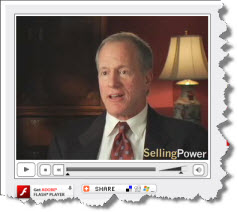 As ESR continues to assess our clients’ sales challenges, we maintain that having the wrong people in the sales jobs is, in many cases, the biggest inhibitor to the success of a training intervention. My interview with Todd Harris of PI Worldwide highlighted one of the tools available for sales leaders to get an objective assessment of candidates as well as existing sales personnel.
As ESR continues to assess our clients’ sales challenges, we maintain that having the wrong people in the sales jobs is, in many cases, the biggest inhibitor to the success of a training intervention. My interview with Todd Harris of PI Worldwide highlighted one of the tools available for sales leaders to get an objective assessment of candidates as well as existing sales personnel.
I’m far from done with this subject. I wanted to get another perspective, so here are some questions I posed to Kathleen Steffey, CEO of sales recruitment firm Naviga Business Services, based in Tampa. Kathleen also writes the SalesJournal blog.
Dave Stein: As CEO of a national sales and marketing recruitment firm, share with me what changes you’ve seen in your business in the past three months.
Kathleen Steffey: In the last three months I’ve seen growth and expansion with my existing customer base and a decline in “new” customer contracts. Because of this trend, my business has made a shift to heavily focus on existing customer penetration and customer management. We’ve created new programs to capitalize on our existing customer base-viral marketing campaigns, referral programs, aggressive business development penetration (all inside our existing customer base). I am also focusing heavily on recruiting performance to make sure we are executing on every single piece of business we receive to maximize revenue. Customers are behaving in a very smart way and show a thorough decision making process when it comes to candidates. They are taking every aspect of the hiring process much more serious as every penny counts these days. Because my business is steadily growing, we are currently looking for additional recruiters. Our recruiter candidate pipeline is the best I’ve seen in years, in terms of quality. I am taking advantage of the down market to select only the best and brightest to join my team in the next month.
DS: I’m curious about high-performing sales reps. Do you see them looking for new opportunities or are they sticking with the companies for which they are currently working?
KS: The volume of candidate flow has increased dramatically. Many, many “A” player sales reps have been laid off and/or are looking for a new opportunities due to the instability of their current employer. I personally know many sales executives who have contacted me to express that they are looking for a new opportunity. They are coming out of the woodwork right now.
DS: What about sales managers? Any new trends there? Are your clients hiring?
KS: I have seen a trend of customers that have a strong focus on evaluating overall team sales performance and linking it back to poor sales leadership. A handful of my customers are deciding to really clean shop and terminate low performing sales reps and terminate non-influential sales leaders. We have many confidential searches going on that support this scenario.
DS: What advice might you give to a sales rep or manager who is currently employed? Stick where they are or look around for a better opportunity?
KS: If someone is employed with an organization that is reacting well to this current economy-shifting, changing, creating, enhancing, looking at different verticals to penetrate, etc, then you have a proactive organization that is adjusting to the current state and shows promise. I say stick it out and keep at it… Penetrate your prospects harder than ever and make sure you’re creating value, providing solid industry insight and serving them well.. better than you ever have.
I can’t comment on whether or not someone should stay with their organization.. it completely depends on the state of the business, industry, product, etc. I do know that two of the hottest industries that are doing well right now are healthcare and energy, in the event people need focus on where to look.
DS: I know your firm does about 20% retained and 80% contingency work. What advice can you give a hiring authority as to which way to go?
KS: While both options offer our customers the same level of attention and quality, I would have to suggest that going retained always wins. A retained relationship brings focus, commitment and efficiency to the customer/vendor partnership and displays strong value in filling the position with Naviga. At the very least, a retained relationship removes other variables that the hiring manager would normally have to deal with if working contingency-job advertisements, other recruiters, internal responses to postings, etc. A retained relationship allows Naviga to streamline the recruiting process and save valuable time for our customers.
DS: How is your firm helping companies hire the right candidates? As you know, ESR’s research identifies this as a big, big problem.
KS: First and foremost we get to know our customers. I view this as a critical piece in quality recruiting and making an appropriate match. We understand the make-up of the organization—revenues, employees, top leadership style, product/service focus, market differentiation, strengths/weaknesses, etc. Next we get to the critical part of the engagement and this is where we reveal the sales culture/environment. We understand the sales team, territories, product price, sales cycle, ramp up, top performer profiles, sales leadership and how the team is led, CRM/reporting requirements, candidate profile, etc. We’ve found that there is a significant correlation with how the team is led and the performance of the overall team. We take this discovery serious to determine if our candidates will be in an environment where they can be successful.
I am a strong advocate of this statement, “The best predictor of future performance is past performance”.. I train and coach my team to measure the quality of the candidates by their past performance and to relate the sales environment associated with those successes to the current position we are looking to fill. I am also a strong advocate of looking at W2’s, understanding the past compensation programs, looking at industry, product/services, average sales cycle and deal price and evaluate whether or not there is a sales environment/culture match.
Because Naviga specializes in sales recruitment, our evaluation process is very specialized and “sales centric.” We have a standardized evaluation process that every recruiter uses and it’s based on the position we are recruiting; for an example-it can vary based on hunter, farmer, or leadership positions. We use a standard list of eight (8) key sales dimensions when we interview candidates. We ask questions around selling skills, sales knowledge, intellectual ability, personal, interpersonal, motivation, tenure and compensation. Our internal evaluation process is a hybrid of Greg Alexander’s Top Grading for Sales approach, which is adjusted for our business model/customer needs.
Photo credit: © Lisa F. Young – Fotolia.com
Filed under: Economy, Hiring, Measurement, Professionalism | Tagged: Hiring, Kathleen Steffey, Naviga, PI Worldwide | Leave a comment »
 Here is today’s featured video on SellingPower.com.
Here is today’s featured video on SellingPower.com.









 I’ve been very critical of
I’ve been very critical of  Pick one or more of the resolutions below. Commit, execute, enjoy the results.
Pick one or more of the resolutions below. Commit, execute, enjoy the results.